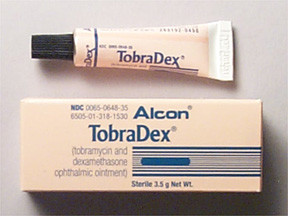TOBRAMYCIN/DEXAMETHASONE OINTMENT - OPHTHALMIC
PHONETIC PRONUNCIATION: (TOE-bra-MYE-sin/dex-uh-METH-uh-sown)
COMMON BRAND NAME(S): Tobradex
GENERIC NAME(S): tobramycin/dexamethasone
Uses
USES: This medication is used to treat or prevent eye infections. This medication contains two drugs. Tobramycin belongs to a class of drugs called aminoglycoside antibiotics. It works by stopping the growth of bacteria. Dexamethasone belongs to a class of drugs called corticosteroids. It works by reducing swelling. This medication treats/prevents only bacterial eye infections. It will not work for other types of eye infections. Unnecessary use or overuse of any antibiotic can lead to its decreased effectiveness.
How to use TOBRAMYCIN/DEXAMETHASONE OINTMENT - OPHTHALMIC
HOW TO USE: Do not wear contact lenses while you are using this medicine. Sterilize contact lenses according to manufacturer's directions and check with your doctor before you begin using them again. To apply the eye ointment, wash your hands first. To avoid contamination, be careful not to touch the tube tip or let it touch your eye. Tilt your head back, look upward, and pull down the lower eyelid to make a pouch. Place a 1/2 inch (1.3 centimeters) strip of ointment into the pouch by squeezing the tube gently. Close the eye and roll the eyeball in all directions to spread the medication. Try not to blink and do not rub the eye. Repeat these steps for your other eye if so directed. Wipe the tip of the ointment tube with a clean tissue to remove excess medication before recapping it. Apply as often as directed by your doctor. Your dosage is based on your medical condition and response to therapy. If you are using another kind of eye medication (e.g., drops or ointments), wait at least 5 to 10 minutes before applying other medications. Use eye drops before eye ointments to allow the eye drops to enter the eye. Use this medication regularly in order to get the most benefit from it. Remember to use it at the same times each day. Continue to use this medication for the full time prescribed, even if symptoms disappear after a few days. Stopping the medication too early may allow bacteria to continue to grow, which may result in a relapse of the infection. Inform your doctor if your condition persists or worsens.
Side Effects
Precautions
Interactions
Overdose
Images
Reviews
Faq for TOBRAMYCIN/DEXAMETHASONE OINTMENT - OPHTHALMIC
Tobramycin/Dexamethasone Ointment is an ophthalmic medication used to treat eye infections caused by bacteria. It is also effective in reducing inflammation and itching associated with certain eye conditions.
You should wash your hands before and after applying the ointment. Tilt your head back and pull down your lower eyelid to create a small pocket. Squeeze a thin strip of ointment into this pocket without touching the tip of the tube to your eye. Blink a few times to evenly distribute the ointment.
Typically, Tobramycin/Dexamethasone Ointment is applied 3 to 4 times per day, or as directed by your doctor. Follow the prescribed dosing schedule and duration of treatment.
Common side effects may include temporary stinging or burning sensation in the eyes, blurred vision, increased sensitivity to light, and mild discomfort. These side effects usually subside on their own. However, if you experience severe or persistent side effects, contact your healthcare provider.
It is generally recommended to avoid wearing contact lenses while using the ointment. Discuss with your doctor if you can temporarily switch to glasses during the treatment period.
No, this ointment is specifically designed to treat bacterial eye infections. It is not effective against viral infections. Using it for viral conditions may worsen the symptoms and delay the appropriate treatment.
If you forget to apply a dose, apply it as soon as you remember. However, if it is almost time for your next scheduled dose, skip the missed dose and continue with your regular dosing schedule. Do not double the amount to make up for the missed dose.
Yes, Tobramycin/Dexamethasone Ointment can be used in children, but the dosage and duration of treatment may differ based on their age and condition. Consult with a pediatrician or eye specialist for appropriate guidance.
It is best to consult with your healthcare provider before using this medication if you are pregnant or breastfeeding. They can assess the potential risks and benefits and provide appropriate guidance for your specific situation.
Disclaimer
IMPORTANT: HOW TO USE THIS INFORMATION: This is a summary and does NOT have all possible information about this product. This information does not assure that this product is safe, effective, or appropriate for you. This information is not individual medical advice and does not substitute for the advice of your health care professional. Always ask your health care professional for complete information about this product and your specific health needs.


No Reviews Yet